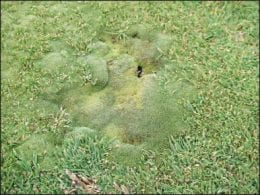By Wes Dyer (Ph.D. student)
The dreaded check engine light popped on this past month. Bound to happen to a 15-year-old vehicle, pushing a quarter of a million miles. I immediately stopped by a local auto parts store and connected a diagnostic scanner to find a faulty fuel level sensor. Not the worst diagnostic error, but I knew I had to be more aware of the miles I drive between refueling. It reminded me of a quote by Dr. Dana Lonn, former managing director for technology at Toro Company, in which he states, “controlling an irrigation system without soil moisture data, is like driving a car without a gas gauge.” I realized more than ever what he meant as I found myself making more frequent stops at the gas station to refuel this past month, just to be sure.
The rootzone profile is much like a fuel tank, where adequate water, or “fuel”, is needed in the profile to maintain a healthy turfgrass stand. How do you know when to refill your soil profile? Setting irrigation clocks to specific days of the week to water is prone to lead to overwatering, like myself now, making more stops than necessary to refuel the vehicle. Even calculating daily evapotranspiration rates (which are estimates of the water used by turfgrass) fail to accurately account for moisture in the soil profile. Utilizing technology and devices to determine soil moisture is much like a fuel level sensor that can aid in determining when the plant needs water. This is where implementing technology in the landscape has advantages. The greater period you can stretch between irrigation applications, the greater chance a rainfall event will occur which will serve as “free water”, though I do not anticipate free gas events.

For the past three years, I have been working to determine how to best employ technology in the turf landscape. Soil moisture sensors are one of many tools we can use to precisely determine when irrigation is needed to maximize water savings, increase turfgrass quality, provide consistent playing conditions, and minimize overwatering. Research results from 2020 indicated soil moisture sensor-based irrigation yielded 84% water savings compared to frequency-based irrigation (2x week-1) and 72% savings compared to deficit evapotranspiration (60% ET) irrigation. These significant water savings were achieved by simply monitoring soil moisture and watering only when necessary to “refuel the tank.” For more information as reference to this project, see this past article (Development of Irrigation Scheduling Techniques that Conserve Water in Turfgrass Landscapes using Soil Moisture Sensors and Weather Data. Kansas Turfgrass Foundation Newsletter, September 2019).
Throughout my turfgrass management career, I have had the opportunity to work with many great golf course and athletic field facilities across the United States. Many of those managers took on the philosophy to be data-driven because it removes the guesswork. The more data available at one’s fingertips the better decisions one can make. The key is not to become overwhelmed with the data, however, but to use the data to aid in improving your decisions or as a “tool in the toolbox”. Regarding irrigation, automated systems may become more widespread in the future and use sophisticated technology to control irrigation. Until then, we can use the current technology to establish our own automated irrigation decisions. I often like to think about two or three simple questions before I choose to irrigate. Specific questions and thresholds center around soil moisture data, turf canopy conditions, and future precipitation forecasts. Certain criteria must be met before the irrigation is turned on which has achieved significant water savings while maintaining turfgrass quality. As my research nears an end, I think it is time to schedule that service on my fuel level sensor.



